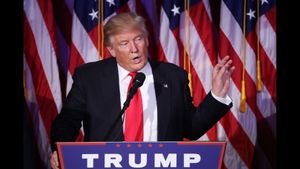Retailers across the United States are bracing for significant changes as former President Donald Trump unveils new tariff proposals, which have raised alarm bells for the National Retail Federation (NRF) and consumers alike. The proposed tariffs, including universal levies of 10-20 percent on imports and even steeper tariffs of 60-100 percent on goods from China, are projected to have far-reaching impacts on American shoppers, potentially squeezing their budgets and altering retail dynamics.
According to the NRF, these tariff measures could drain between $46 billion and $78 billion from consumers’ annual spending power. This staggering figure is drawn from the NRF's recent study, "Estimated Impacts of Proposed Tariffs on Imports: Apparel, Toys, Furniture, Household Appliances, Footwear and Travel Goods," which analyzes how the proposed tariffs would affect key consumer categories. Items likely to see price hikes include apparel, toys, furniture, household appliances, footwear, and travel goods.
"Retailers rely heavily on imported products and manufacturing components so they can provide diverse and affordable offerings to their customers," explained Jonathan Gold, NRF’s vice president of supply chain and customs policy. He emphasized, "These proposed tariffs are effectively taxes paid by U.S. importers, which means the financial burden falls directly on consumers through inflated prices."
Experts have identified the potential impact of these tariffs: under the new regime, prices for certain products could soar significantly. For example, they predicted the cost of a standard $50 pair of athletic shoes could increase to between $59 and $64. Meanwhile, consumers would see the price of common household items, such as mattresses, escalate from $2,000 to between $2,128 and $2,190.
Further dissecting the proposed tariffs, the NRF found some alarming predictions: consumers are expected to pay between $13.9 billion and $24 billion extra for apparel, and between $8.5 billion and $13.1 billion more for furniture alone. These costs could put pressure on families, particularly those with lower incomes, who might struggle to absorb the additional expense.
On the other hand, some domestic manufacturers might see temporary benefits from these tariffs as U.S. production could be stimulated. Nevertheless, Gold asserts, any potential gains at the producer level do not offset the overwhelming losses faced by consumers.
The anticipated spikes in retail prices align with broader economic concerns. With U.S. inflation already elevated—hitting rates as high as 8 percent recently—additional tariffs would compound these issues. Lynn Song, chief economist for Greater China at ING, noted, "If new tariffs are fully passed through to consumers, Americans will see substantial increases in costs for everyday items, exacerbated by Trump’s pledged tax cuts and increased fiscal spending. It’s likely to fuel inflation even more."
Inflation tends to hit low-income families hardest. Advanced estimates from the NRF indicate the influence of proposed tariffs extends beyond immediate cost increases—it reflects consumers' ability to spend overall, which has been restrained as many already prioritize necessary purchases amid rising living costs. "This limits consumer expenditure and reinforces frugality among American households, especially as they navigate economic uncertainties," added economists.
Add to this, the political calculus involved—Trump has consistently linked his tariff proposals to trade negotiations, especially with China and Mexico. Recently, at campaign rallies, he reiterated his commitment to enforce punitive tariffs, threatening rates up to 25 percent on Mexican imports, contingent on Mexico’s intervention against fentanyl trafficking.
Trump remarked, "Every damn thing they sell to the United States is going to come with like a 25 percent tariff until they stop drugs from coming across the border. Those drugs will stop so fast it’ll make your head spin." This rhetoric not only stirs debate around trade policies but also highlights the intersection of economics and trafficking issues.
The NRF’s findings have been echoed across various economic analyses. It's clear the proposed tariffs can produce significant inflationary pressures and question the affordability of imported goods for American consumers. Experts worry this could pull the rug out from under the progress made since the pandemic’s most severe economic impacts. With Americans already grappling with elevated costs from food to gas, the prospect of renewed tariffs stirs justifiable concern.
Should these proposals come to fruition, the next steps could involve negotiations and pushback from the countries involved, meaning the ripple effects might include broader trade tensions. Many analysts warn primarily against inflationary environments as costs soar, leading to less disposable income and potentially disadvantaging the U.S. economy considerably.
To mitigate fallout, some retailers might explore alternative sourcing strategies or lobbying efforts aimed at curtailing proposed tariff modifications. Nevertheless, any changes seem reliant on broader political changes within the forthcoming elections.
The upcoming months could very well shape the retail and consumption landscapes, pushing retailers and their customers to prepare for the various challenges upcoming elections and tariff implementations may bring.
While Trump remains steadfast about his tariff proposals signaling tough on trade practices, the chorus of discontent from retail groups continues. The NRF has consistently spoken out against strategies perceived as detrimental to the average consumer. This mounting pressure amplifies as voices from across the political aisle unite to advocate for modified approaches to trade, questioning whether end-users should bear the brunt of economic policies ostensibly aimed at international competitors.
It’s still early to predict the full scope of potential economic disruptions should these tariffs land on American shores, but one thing remains certain: consumers will be watching closely, as every decision reverberates through their wallets and modulates their shopping habits. Are we heading toward more expensive shopping experiences as yet another election season unravels the fabric of consumer confidence and economic stability?



